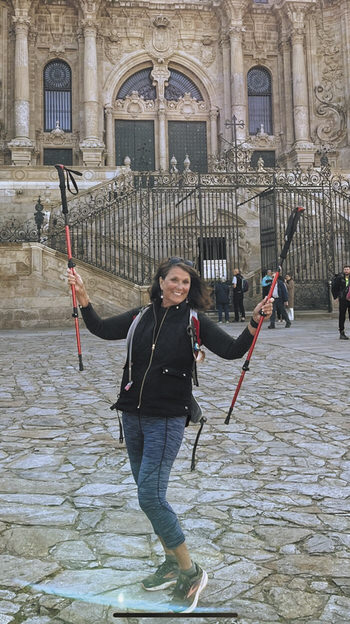
Lonnie Gisi finishing the Camino
At a recent Kiwanis Club meeting, Lonnie Gisi and Kathy Bailey shared their experiences walking 500 miles on the ancient path from Saint-Jean-Pied-de-Port, France, to Santiago de Compostela, Spain. Also in attendance were two other Robson residents who hiked the Camino: Steve Bailey and Erminja Maganja. Kathy and Lonnie shared the rich history associated with the Camino de Santiago, how they approached their journeys, and the lessons they brought home.
Camino de Santiago, in English, means “The Way of St. James.” James, one of the 12 apostles, was martyred in Jerusalem in 44 AD. After his death, tradition says his remains were carried to Spain. In the 9th century a church was built to honor him. Construction of the cathedral was begun in 1075. From the 9th century to the present, millions have made their way to Santiago de Compostela, traveling on a network of trails across France and Spain.
While the Camino de Santiago may ostensibly be a Christian pilgrimage, many people of other faiths (or no faith) have walked this path for a myriad of reasons. An interest in culture, a physical challenge, contact with nature, a spiritual journey—whatever your motivation—the Camino is a once-in-a-lifetime experience you may feel compelled to do more than once.
Medieval villages, Roman bridges, centuries-old monasteries and churches, castles and cathedrals, art, and varied cuisines and cultures abound. The landscape is beautiful and diverse. The Camino Frances traverses three mountain ranges and 200 kilometers of high plains. You walk through vineyards, valleys, forests, cities, medieval villages, and hamlets.
Kathy shared how walking in silence for hours awakens your senses. Removed from distractions, you experience things you would have never noticed in the hurry of everyday life. However, when you leave the solitude and come back together with others, you discover that time spent in community is made richer because of time spent in solitude.
Lonnie shared how she came to love humanity. She discussed the beauty of entering into another person’s life as she interacted with other pilgrims on the way and how she brought the people she met home with her. Kathy quoted the proverb, “Joy shared is joy doubled; and sorrow shared is sorrow halved.” As these ladies walked their Camino, they took the time to bear others’ burdens. But they also had the opportunity to enter into others’ joys.
The Camino de Santiago is not just about reaching a destination. It is about going into the world, crossing boundaries, caring for others, and becoming more comfortable with different beliefs, values, and cultures. You might not be inclined to hike the Camino, but you can have the Camino experience right here in your own community. You need only slow down and take time to interact with the people all around you. The Camino, as with life, is what you make it.
